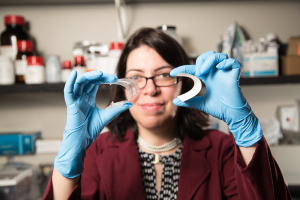Imagine a battery that doesn't fit neatly into its appointed slot, one that's neither cylindrical nor square shaped, but perhaps as thin as a business card and as stretchy as Play Dough. If you can envision that, then you've just jumped into the mind of Haleh Ardebili, Bill D. Cook Associate Professor in mechanical engineering at the UH Cullen College of Engineering.
Ardebili is a bit of a juggler, with two new grants worth more than half a million dollars. What’s more, her funding for energy storage research stretches – like her batteries – from the depths of the sea with an award from the Subsea Systems Institute, to the outer reaches of the atmosphere with money from the Air Force Office of Scientific Research (AFOSR).
Making smart uniforms even smarter
For the Air Force, Ardebili, principal investigator Jodie Lutkenhaus at Texas A&M University, and other co-PIs at A&M may just end up making smart uniforms last longer – and the timing couldn’t be better.
On April 1, U.S. Secretary of Defense Ash Carter, a physicist, said textile manufacturers will soon create fabrics and cloths "that can see, hear, sense, communicate, store energy, regulate temperature, monitor health, change color and more."
But the batteries that power all of that have to be charged and integrated into the material so that those who serve can feel comfortable in their own skin.
“We’re looking at how the fibers come together with the graphene,” said Ardebili. “So we’ll look at the electrochemical properties and mechanical properties, too.” It’s the kind of flexible battery that Ardebili makes in her lab. That’s why she likes to bend it and have her students play with it. It’s all research.
“Externally, if you bend it, what’s going to happen with it?” she wonders. ““And what happens internally when the lithium ions stress the electrode?” She conducts research on both levels.
That’s what the research is focused on, technically known as aramid nanofiber-functionalized graphene electrode for structural energy storage, and it involves experiments and modeling for the design, testing and analysis of ANF/FG electrodes. The total award is approximately $1M; the portion for UH is $260,000.
Powering down below the ocean
The Subsea Systems Institute Award for $300,000 is a collaboration between Ardebili and Jim Tour of Rice University. This research project is focused on the fabrication, testing and analysis of batteries and supercapacitors for subsea applications.
Whether it’s an oil rig or an autonomous underwater vehicle (AUV), batteries can supply the power that keeps them working - during an emergency power outage in an oil rig, or during normal AUV operation. Ardebili’s goal is to make sure those batteries are as safe as possible.
To make safer batteries, she is replacing the flammable organic liquid electrolyte currently inside of traditional lithium-ion batteries with polymer electrolytes, which are not flammable.
“Safety is number one in my mind. The most compelling reason we would have a polymer electrolyte and not an organic liquid electrolyte is safety,” said Ardebili.
Her next goals are to get the batteries to last longer while providing design flexibility (the bendable, stretchy batteries of which she’s so proud).
“We’re not bound to these rigid space requirements,” said Ardebili. “You can bend it, it can conform to various shapes.”
For subsea applications, the design is enhanced to make sure it isn’t vulnerable to pressure and corrosion. Casings and boxes are built to protect the electronics inside, but instead of the battery getting bigger and bigger with each protective layer added, it is paper thin.
“Materials are very important, and if they are flexible and can conform to various spaces at least you are opening up some design parameters that allow more space-efficient design, so hopefully you have more space for other requirements in those vehicles,” she said.
Energy becomes her
Ardebili herself is filled with energy as she speaks about the world she envisions, where batteries are integrated into every aspect of our lives – walking on shoe-charging batteries, wearing clothes that are electronically integrated and, mostly, continuing to question what people think is normal about energy science.
“Just kind of flipping upside down the traditional understanding of how batteries are supposed to behave, I ask, ‘Really? Do they have to?’” Ardebili says.
No, they don’t. Not in Ardebili’s world. And soon, because of her continuous questioning and research, not in ours, either.
